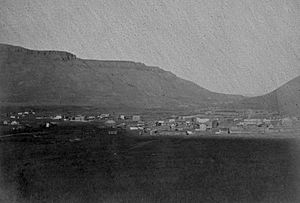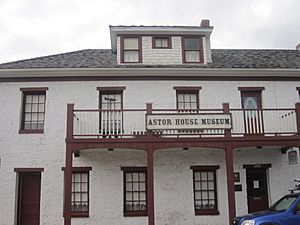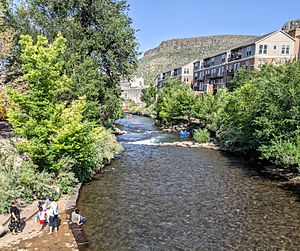Golden, Colorado facts for kids
Quick facts for kids
Golden, Colorado
|
||
|---|---|---|
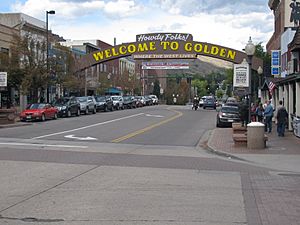
Downtown Golden, Colorado
|
||
|
||
| Motto(s):
"Where the West Lives"
|
||

Location of the City of Golden in Jefferson County, Colorado
|
||
| Country | ||
| State | ||
| County | Jefferson County seat | |
| Founded | June 16, 1859, as Golden City, Kansas Territory |
|
| Incorporated | January 3, 1871, as Golden City, Colorado Territory | |
| Named for | Thomas L. Golden | |
| Government | ||
| • Type | Home Rule Municipality | |
| Area | ||
| • Home rule city | 25.193 km2 (9.727 sq mi) | |
| • Land | 24.953 km2 (9.634 sq mi) | |
| • Water | 0.240 km2 (0.093 sq mi) | |
| Elevation | 1,763 m (5,784 ft) | |
| Population
(2020)
|
||
| • Home rule city | 20,399 | |
| • Density | 817/km2 (2,117/sq mi) | |
| • Metro | 2,963,821 (19th) | |
| • CSA | 3,623,560 (17th) | |
| • Front Range | 5,055,344 | |
| Time zone | UTC−07:00 (MST) | |
| • Summer (DST) | UTC−06:00 (MDT) | |
| ZIP Codes |
80401-80403, 80419, 80439
|
|
| Area codes | Both 303 and 720 | |
| FIPS code | 08-30835 | |
| GNIS feature ID | 2410611 | |
| Interstate highway | ||
| U.S. highways | ||
| State highways | ||
| Light rail | W | |
|
|
||
Golden is a city in Colorado, United States. It is the main city of Jefferson County. In 2020, about 20,399 people lived there. Golden is located along Clear Creek at the base of the Rocky Mountains.
The city was founded on June 16, 1859, during the Pike's Peak Gold Rush. It was first called Golden City, named after Thomas L. Golden. Golden City was the capital of the Territory of Jefferson from 1860 to 1861. It was also the capital of the official Territory of Colorado from 1862 to 1867. Later, the capital moved to Denver. Today, Golden is part of the larger Denver–Aurora–Lakewood, CO Metropolitan Statistical Area.
Golden is home to the Colorado School of Mines, a famous university for engineering and science. It also has the National Renewable Energy Laboratory, which studies clean energy. Other important places in Golden include the Coors Brewing Company, Colorado Railroad Museum, and the American Mountaineering Center. The famous showman William F. "Buffalo Bill" Cody is buried nearby on Lookout Mountain.
Contents
History of Golden
Golden City started during the Pike's Peak Gold Rush. It quickly became an important place for business and politics. Its location made it a good spot for trade between the gold fields in the west and other towns in the east. The city was founded on June 16, 1859, by Clear Creek. Early settlers included William A.H. Loveland and George West.
Golden as Capital City
By late 1860, Golden City was chosen as the seat of Jefferson County. It also became the capital of the temporary Jefferson Territory. Golden was picked because it was close to mountain mining towns. It was also easier for lawmakers to meet there than in Denver.
Golden City lost its capital status for a short time in 1861. Another small town, Colorado City, became the temporary capital. But this change did not last long. On August 4, 1862, the government voted to move the capital back to Golden.
Even though many people left Golden during the Civil War, it became the capital of the official Colorado Territory on August 2, 1862. It remained the capital until 1867.
Railroad Race
Between 1862 and the early 1870s, Golden and Denver had a big competition. Both cities wanted to build a railroad to connect to the new transcontinental railroad in Cheyenne. This railroad would bring more trade and power.
W.A.H. Loveland started the Colorado Central Railroad in 1865 for Golden. Denver also began building its own railroad, the Denver Pacific Railway. Denver's newspaper, The Rocky Mountain News, urged people to support their railroad.
By 1869, Denver's railroad was ahead. Golden's railroad started building west into mining towns like Georgetown. By 1870, Golden officially lost the race to Cheyenne. Denver became the main city and capital. The Colorado Central Railroad did connect to Cheyenne in 1877, but by then, Denver was already the more powerful city.
Growth and Change
Golden became known as the "Lowell of the West." This meant it was a center for trade and industry. It had flour mills, smelters, and the first railroad into the Colorado mountains. The Coors Brewery started here, along with brick works and a paper mill.
In the 1870s, Golden also became home to three colleges. The Colorado School of Mines is the only one that remains today. Golden had an opera house and seven churches. Many immigrants from Germany, Switzerland, Sweden, Italy, and China came to live in Golden.
By the early 1900s, Golden had about 2,500 people. Some industries closed, but others like brewing and brick making continued. The city became more connected with two trolley lines to Denver. Downtown Golden was improved with new lights and schools. The city survived tough economic times, like the Silver Crash of 1893 and the Great Depression.
After World War II, Golden grew very fast. Its population and size increased. In 1959, the city almost tripled in size by adding new areas. New neighborhoods were built, and public buildings like the city hall and library were modernized.
In the 1980s, the downtown area faced problems. But in the 1990s, it was improved again. The old Golden High School became the American Mountaineering Center. The Coors Brewery became the largest single-site brewery in the world. Golden also became home to the National Renewable Energy Laboratory, which works on clean energy.
Geography and Location
Golden is located just north of I-70 and west of Denver. It sits at the foot of the Rocky Mountains. The city is in a valley between Lookout Mountain and the two Table Mountains. Clear Creek flows through the town from the west. It exits the valley between North Table Mountain and South Table Mountain, where the Coors Brewery is located.
In 2020, Golden covered about 25.193 square kilometers (9.727 square miles). A small part of this area, about 0.240 square kilometers (0.093 square miles), is water.
Population and People
In 2010, Golden had 18,867 people living in 7,394 households. About 23.7% of households had children under 18. Many people were White (90.6%), with smaller groups of Asian (3.8%), Black (1.2%), and Native American (0.6%) residents. About 8.2% of the population was Hispanic or Latino.
The median age in Golden was 33.9 years. This means half the people were younger than 33.9 and half were older. The population included 24.7% under 20 years old and 10% who were 65 or older.
Arts and Culture
Golden has many museums for you to explore:
- Golden History Museum & Park
- Rocky Mountain Quilt Museum
- Colorado Railroad Museum
- Colorado School of Mines Geology Museum
- Bradford Washburn American Mountaineering Museum
- Mother Cabrini Shrine
The Jefferson Symphony Orchestra performs in Golden. The Foothills Art Center shows art in a historic building. Miners Alley Playhouse offers live theater downtown. The Buffalo Rose Bar and Grill is a very old business from the gold rush days and hosts music shows.
Annual Events
Golden hosts several fun events each year:
- E-Days of the Colorado School of Mines in April (since 1927)
- Golden Music Festival at Clear Creek History Park
- Independence Day celebration by the Golden Lions Club (since 1972)
- Buffalo Bill Days in late July (since 1946) – the biggest event!
- Golden Fine Arts Festival in August (since 1990)
- Olde Golden Christmas from November to December (since 1972)
Mountaineering Hub
The American Mountaineering Center is a major center for mountain climbing. It holds the world's largest collection of mountaineering books. It also has the Bradford Washburn American Mountaineering Museum. Because of its location near great climbing and skiing spots, Golden is a hub for mountaineering culture.
Beer Culture
Golden is famous for its beer! It has several smaller breweries, including:
- Golden City Brewery
- Mountain Toad Brewing
- Cannonball Creek Brewing Company
- Barrels & Bottles Brewery
- Holidaily Brewing Company
- Over Yonder Brewing
- Ohm Brewing
Beer festivals in Golden include UllrGrass in January, Goldenfest in September, and the Knock Your Boots Off Beer Tasting and Chili Cook-off in October.
The main office and brewery of Coors Beer are in Golden. The company started here in 1873 and has stayed ever since. You can take tours of the brewery. Coors is one of the biggest employers in Golden, with 900 full-time workers.
Sports and Recreation
Golden has a long history of sports. Golden High School teams compete in various sports. The Colorado School of Mines also has many sports teams, including football and basketball.
Clear Creek has a famous kayak course. The city is also a great place for rock climbing, mountain biking, hiking, and hang gliding. Golden has produced several professional baseball players and Olympic medalists.
Education in Golden
Golden was home to one of the first schools in Colorado. Today, it is part of the Jefferson County R-1 School District. This district provides public education for the area.
Golden has four elementary schools: Mitchell, Kyffin, Shelton, and Ralston Elementary. It has one middle school, Bell Middle School. It also has Colorado's oldest senior high school, Golden High School.
For higher education, Golden is home to the Colorado School of Mines. This is the oldest public university in Colorado. It is located on a hill overlooking the city. The Mountain Language Institute is also nearby, offering English language classes.
Media and News
Golden has several local newspapers:
- Golden Transcript – started in 1866
- The Oredigger – the student newspaper for the Colorado School of Mines, started in 1920
- The Coffee News – started in 2009
Transportation
City Streets
Golden's main streets are set up in a grid pattern. They follow the path of Clear Creek. Most streets are paved and have sidewalks. The main street is Washington Avenue, which has a special downtown look with trees and lights. Streets running east-west are usually numbered, and north-south streets are named after pioneers or tribes.
Highways
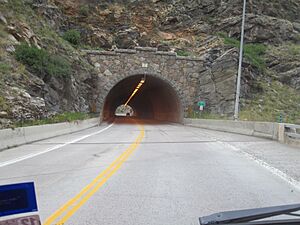
Golden has always been a place where major roads meet. Today, Interstate 70 (I-70) runs through the southern part of the city. U.S. Highway 6 (US 6) also goes through Golden. State Highway 93 (SH 93) goes north towards Boulder. SH 58 cuts through Golden from east to west.
Public Transport
Golden is part of the Regional Transportation District (RTD) network. This provides bus and light rail service for the Denver area. The West Corridor (W line) of the FasTracks light rail opened in 2013. This line connects Golden to other parts of the city. There is also a local bus service called Community Call-n-Ride.
Golden still has railroad lines for cargo, which have been used since 1870. These lines are owned by the BNSF railroad.
Airports
The closest airport to Golden is Rocky Mountain Metropolitan Airport. This airport is for private planes. For passenger flights, most people use Denver International Airport in Denver.
Notable People
- Lindsey Horan: Captain of the United States women's national soccer team and professional soccer player. She went to Golden High School.
- Edward L. Berthoud: Engineer and historian.
- Adolph Coors: Founder of the Coors Brewing Company.
- Gertrude Käsebier: Famous photographer.
- Gudy Gaskill: Key person behind the creation of the Colorado Trail.
See also
 In Spanish: Golden (Colorado) para niños
In Spanish: Golden (Colorado) para niños




